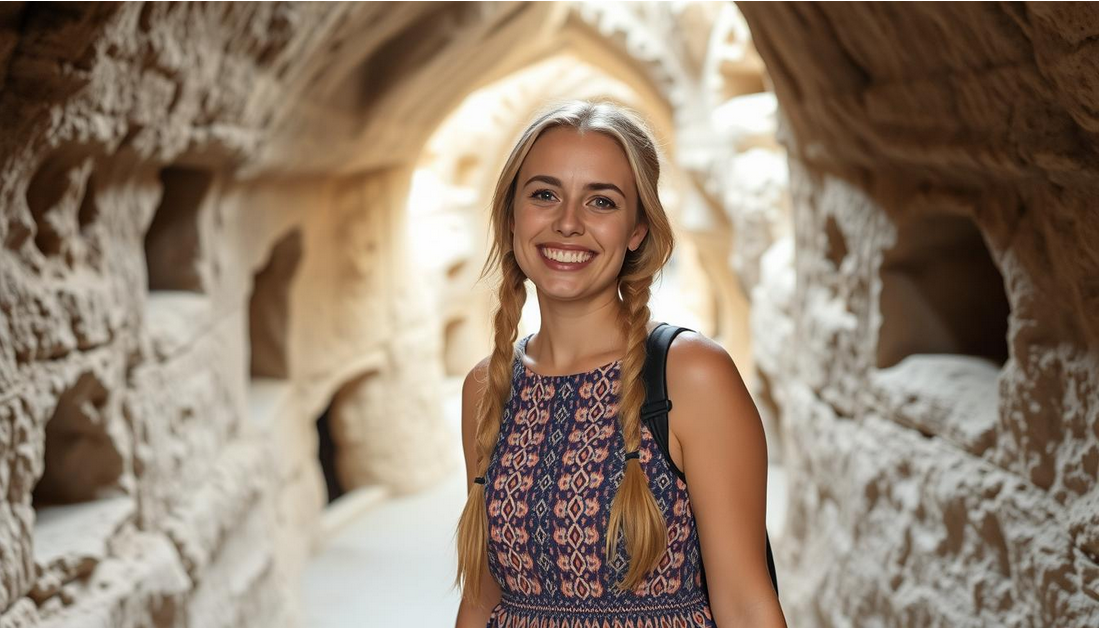India customers to view on amazon.in
Cappadocia Beyond Balloons: Exploring Underground Cities
Imagine a world where ancient civilizations carved out intricate networks beneath the earth’s surface. Welcome to Cappadocia, a region in Turkey that offers a unique travel experience.
- The Hidden Wonders of Cappadocia
- The Rich History Behind Cappadocia’s Underground World
- Derinkuyu: The Deepest Underground City
- Kaymakli Underground City: A Maze of Tunnels
- Lesser-Known Underground Cities Worth Exploring
- Cappadocia Beyond Balloons: Exploring Underground Cities in Depth
- The Engineering Marvel of Ancient Ventilation Systems
- Security Features: How Cities Protected Their Inhabitants
- The Cultural Significance of Cappadocia’s Underground World
- Planning Your Underground Exploration: Practical Tips
- Best Times to Visit for Fewer Crowds
- What to Wear and Bring for Underground Exploration
- Guided Tours vs. Self-Exploration
- Where to Stay: Cave Hotels and Unique Accommodations
- Beyond the Underground: Complementary Experiences in Cappadocia
- Hiking Through Valley of Imagination
- Open-Air Museums and Ancient Rock Churches
- Local Cuisine and Cultural Experiences
- Conclusion: The Timeless Appeal of Cappadocia’s Hidden World
- FAQ
- What are the must-visit underground cities in Cappadocia?
- How were the underground cities in Cappadocia discovered?
- What is the best time to visit Cappadocia’s underground cities?
- Are guided tours available for the underground cities?
- What should I wear when visiting the underground cities?
- Can I visit the underground cities on my own?
- Are the underground cities suitable for all ages?
- How long does it take to explore an underground city?
- Are there any unique experiences or activities available in Cappadocia beyond visiting the underground cities?
- What are some of the lesser-known underground cities in Cappadocia worth exploring?
While hot air balloon rides are a popular attraction, there’s more to Cappadocia than breathtaking views from above. The region is home to fascinating underground cities that showcase the ingenuity and resilience of its past inhabitants.

As you explore these subterranean wonders, you’ll uncover the secrets of a bygone era. From narrow passageways to spacious chambers, Turkey’s rich history comes alive in these remarkable structures.
Key Takeaways
- Discover the hidden gems of Cappadocia beyond the hot air balloon rides.
- Explore the fascinating underground cities that dot the region.
- Experience the unique culture and history of Turkey.
- Uncover the secrets of the ancient civilizations that once inhabited these underground networks.
- Enjoy a travel experience that’s off the beaten path.
The Hidden Wonders of Cappadocia
Beyond the hot air balloons, Cappadocia holds a treasure trove of ancient secrets and natural wonders. The region’s unique landscapes, shaped by millions of years of erosion, have created a surreal environment that captivates visitors from around the world.

A Land of Fairy Chimneys and Ancient Secrets
Cappadocia is famous for its fairy chimneys, tall, thin spires of rock that have been formed through erosion. These natural wonders, along with the region’s ancient secrets, draw tourists and historians alike. The fairy chimneys are not just visually stunning; they also hold historical significance, having been used as dwellings and religious sites in the past.
Beyond the Instagram-Famous Balloon Rides
While the hot air balloon rides are a major attraction, Cappadocia offers much more to explore. The region is home to numerous underground cities, ancient complexes that were used for refuge and habitation. These cities, with their intricate tunnel systems and historical significance, provide a deeper understanding of the region’s past and its people.
Visitors can explore these underground wonders, experiencing the unique blend of natural beauty and historical richness that Cappadocia has to offer.
The Rich History Behind Cappadocia’s Underground World
Beneath the surface of Cappadocia lies a rich history, hidden within the labyrinthine passages of its underground cities. This fascinating region has been home to numerous civilizations, each contributing to the complex network of underground refuges that crisscross the area.
Ancient Civilizations and Their Underground Refuges
The history of Cappadocia’s underground world dates back to ancient times, with evidence suggesting that Hittites, Greeks, and Romans all inhabited or utilized these subterranean structures. The earliest known constructions are believed to have been built by the Hittites in the 2nd millennium BCE. Over time, other civilizations expanded and modified these underground cities to suit their needs.
The construction of these underground refuges was not merely a matter of digging holes in the ground; it involved sophisticated engineering and planning. The ancient inhabitants of Cappadocia demonstrated a deep understanding of the local geology, utilizing the soft tuff stone to create complex networks of tunnels and chambers.
Why Underground? The Strategic Importance
The decision to build underground cities was largely driven by the need for protection from invaders and harsh climatic conditions. The unique geology of Cappadocia, with its soft volcanic rock, made it an ideal location for digging complex underground structures.
Protection from Invaders and Climate
The underground cities provided a safe haven during times of conflict, allowing communities to hide and survive. The thick layers of rock above ground also offered natural insulation against the extreme temperatures of the region, providing a stable and relatively comfortable living environment.
Community Survival Strategies
Life underground required careful planning and communal effort. Ventilation shafts, storage rooms, and communal areas were all part of the intricate design of these underground cities. The inhabitants developed sophisticated strategies for survival, including communal kitchens, wineries, and even schools.
| Feature | Description | Importance |
|---|---|---|
| Ventilation Shafts | Provided fresh air to the underground dwellings | Essential for survival |
| Communal Kitchens | Allowed for food preparation on a larger scale | Facilitated community living |
| Storage Rooms | Stored food and supplies for extended periods | Crucial for long-term survival |

Derinkuyu: The Deepest Underground City
Among the numerous underground cities in Cappadocia, Derinkuyu holds a special place due to its remarkable depth and complex structure. This ancient marvel is a testament to the ingenuity of its builders, who constructed an extensive network of tunnels and rooms that could sustain thousands of people.
Eight Levels of Ancient Engineering
Derinkuyu is renowned for its eight levels of underground construction, with the deepest parts reaching approximately 60 meters below the surface. The engineering feats achieved here are remarkable, particularly in terms of the ventilation system and water storage facilities.
The Remarkable Ventilation System
The ventilation system in Derinkuyu is a marvel of ancient engineering. It was designed to provide fresh air to the inhabitants throughout the extensive network of tunnels. This was achieved through a sophisticated network of air shafts that ensured a constant flow of air, even at the deepest levels.
Water Wells and Storage Areas
In addition to its impressive ventilation system, Derinkuyu also features elaborate water wells and storage areas. These were crucial for the survival of the inhabitants, providing them with clean water and storage for food and other supplies. The water wells were particularly important, as they ensured a steady supply of fresh water even during prolonged periods of hiding.
Life in the Depths: How People Survived Underground
Life in Derinkuyu was challenging, but the inhabitants developed strategies to survive and even thrive in their underground environment. The city was designed to be self-sufficient, with areas for food storage, livestock, and even chapels for worship. The inhabitants also developed social structures and routines that allowed them to maintain a sense of community and normalcy despite their unusual circumstances.
Some of the key survival strategies included:
- Utilizing the natural insulation of the earth to maintain a stable temperature.
- Rationing food and water carefully to ensure supplies lasted as long as possible.
- Maintaining a strict schedule for daily activities to preserve a sense of routine.

Kaymakli Underground City: A Maze of Tunnels
Exploring Kaymakli Underground City is like stepping into a labyrinth, uncovering the secrets of ancient civilizations. This underground marvel, part of Cappadocia’s vast network of subterranean cities, offers visitors a unique glimpse into the region’s history and the ingenuity of its ancient inhabitants.

The Unique Layout and Features
Kaymakli Underground City is renowned for its complex layout, which includes narrow passageways, ventilation shafts, and rooms that were used for various purposes, from living quarters to storage facilities. The city’s design showcases the advanced engineering skills of its builders, who managed to create a self-sufficient underground community.
The layout is characterized by its narrow tunnels and multiple levels, which were designed to confuse potential invaders and protect the inhabitants. This unique feature has captivated visitors and historians alike, offering insights into the lives of those who lived underground.
Visitor Experience: Navigating the Narrow Passages
Visiting Kaymakli is an adventure that requires navigating through its narrow passages and dark tunnels. The experience is both exhilarating and humbling, as visitors get to walk in the footsteps of ancient civilizations.
What to Expect During Your Visit
Visitors should be prepared for a physically demanding experience, as the terrain can be challenging. Comfortable shoes and a moderate level of physical fitness are recommended. The city’s narrow passages and low ceilings can be claustrophobic for some, so it’s essential to be aware of your surroundings.
Photography Tips for Dark Spaces
Capturing the beauty of Kaymakli’s underground world requires some skill and the right equipment. Using a tripod and a camera with good low-light performance can help you capture the intricate details of the city’s architecture. “The darkness of the tunnels can be challenging, but it’s also what makes the photos so dramatic,” notes a seasoned photographer.
As you explore the depths of Kaymakli, remember to take your time and appreciate the historical significance of this underground city. With its unique layout and fascinating history, Kaymakli Underground City is a must-visit destination for anyone interested in Cappadocia’s rich cultural heritage.
Lesser-Known Underground Cities Worth Exploring
For those willing to venture off the beaten path, Cappadocia’s lesser-known underground cities provide an unforgettable adventure. While Derinkuyu and Kaymakli are popular among tourists, there are other hidden gems that offer a more secluded and intimate experience with Cappadocia’s ancient underground world.

Özkonak: The City with a Unique Communication System
Özkonak, located near the village of Özkonak, is an intriguing underground city known for its sophisticated ventilation and communication system. Built in the 8th century BC, it features a complex network of tunnels and rooms spread across four levels. One of its standout features is the presence of a unique communication system, which allowed the inhabitants to communicate with each other over distances. This system, combined with its well-preserved state, makes Özkonak a fascinating site for visitors interested in history and archaeology.
| Underground City | Depth | Notable Features |
|---|---|---|
| Özkonak | 4 levels | Unique communication system, sophisticated ventilation |
| Mazı | 3 levels | Narrow tunnels, ancient storage rooms |
| Tatlarin | 3 levels | Well-preserved wine and oil presses, stable areas |
Mazı and Tatlarin: Off the Beaten Path
Mazı and Tatlarin are two lesser-known underground cities that offer a glimpse into Cappadocia’s hidden past. Mazı, with its narrow tunnels and ancient storage rooms, provides an authentic underground experience. Tatlarin, on the other hand, is notable for its well-preserved wine and oil presses, as well as its stable areas, giving visitors insight into the daily lives of its ancient inhabitants. Both cities are less crowded than Derinkuyu or Kaymakli, making them ideal for those seeking a more solitary exploration.
Exploring these lesser-known underground cities not only enriches one’s understanding of Cappadocia’s history and culture but also offers a unique adventure off the beaten path. With their unique features and less crowded environments, Özkonak, Mazı, and Tatlarin are must-visit destinations for anyone fascinated by the underground world of Cappadocia.
Cappadocia Beyond Balloons: Exploring Underground Cities in Depth
The underground cities of Cappadocia are a marvel of ancient engineering, with sophisticated ventilation systems and security features. These cities, hidden beneath the surface, reveal the ingenuity and resilience of the people who built them. As we explore these underground wonders, we uncover the secrets behind their construction and the lives of those who inhabited them.

The Engineering Marvel of Ancient Ventilation Systems
The ancient ventilation systems in Cappadocia’s underground cities are a testament to the advanced engineering skills of their builders. These systems provided a constant supply of fresh air, making life underground not only possible but also comfortable. The ventilation shafts were carefully designed to circulate air throughout the cities, often extending to the surface to capture fresh air.
Security Features: How Cities Protected Their Inhabitants
The security features of Cappadocia’s underground cities were crucial for protecting their inhabitants from invaders. Two notable security features were rolling stone doors and narrow passages, as well as traps and defense mechanisms.
Rolling Stone Doors and Narrow Passages
Rolling stone doors were used to seal entrances, making it difficult for intruders to access the cities. Narrow passages further enhanced security by limiting the number of people who could enter at once, allowing defenders to control access effectively.
Traps and Defense Mechanisms
In addition to physical barriers, the underground cities employed traps and other defense mechanisms to deter invaders. These traps could be triggered by intruders, providing an additional layer of protection for the inhabitants.
The Cultural Significance of Cappadocia’s Underground World
Beyond their impressive architecture, Cappadocia’s underground cities reveal a rich tapestry of cultural and religious practices that have fascinated historians and tourists alike. These subterranean structures were not just shelters from invaders but also served as vibrant communities that sustained the social, religious, and cultural fabric of ancient societies.

Religious Practices and Underground Churches
The underground churches within these cities are particularly noteworthy, showcasing intricate frescoes and religious symbols that highlight the importance of faith in the daily lives of the inhabitants. These churches, often hidden away in the depths of the underground cities, demonstrate the resilience of religious practices even in the most challenging circumstances.
The Legacy of Underground Living in Modern Culture
The legacy of underground living in Cappadocia continues to influence modern culture, with many contemporary artists, writers, and filmmakers drawing inspiration from these ancient structures. Moreover, the unique history and architecture of these underground cities have made Cappadocia a popular destination for cultural tours, attracting visitors from around the world who are eager to experience the rich cultural heritage of the region.
The cultural significance of Cappadocia’s underground world is multifaceted, reflecting not only the historical importance of these structures but also their ongoing impact on modern culture. As such, efforts to preserve these sites are crucial, not just for historical preservation but also for continuing to inspire future generations.
Planning Your Underground Exploration: Practical Tips
Planning your underground adventure in Cappadocia involves more than just choosing a date; it requires understanding the practical aspects of visiting these unique sites. To make the most of your trip, consider the following tips.
Best Times to Visit for Fewer Crowds
Visiting during the shoulder season (April-May or September-October) can significantly reduce the crowds, making your experience more enjoyable. Early morning or late afternoon visits are also recommended to avoid peak tourist hours.
What to Wear and Bring for Underground Exploration
Comfortable, sturdy shoes are a must due to the uneven terrain and narrow passages. Dressing in layers is also advisable as the underground temperature can be quite different from the surface. Bringing a flashlight or using the light on your phone can be helpful, although most areas are well-lit.
Guided Tours vs. Self-Exploration
Choosing between a guided tour and self-exploration depends on your preference for structure and flexibility. Guided tours offer valuable insights and historical context, while self-exploration allows you to move at your own pace.
Recommended Local Guides and Tour Companies
For those opting for a guided tour, companies like Göreme Guides and Cappadocia Tours are highly recommended for their knowledgeable guides and comprehensive tours.
Self-Guided Options and Audio Tours
For a more independent experience, audio tours can be a great resource. Many underground cities offer audio guides that provide detailed information about the sites.
| Tour Type | Benefits | Cost |
|---|---|---|
| Guided Tour | Historical insights, structured experience | $50-$100 per person |
| Self-Guided | Flexibility, personal pace | $20-$50 per person (audio guide) |

Where to Stay: Cave Hotels and Unique Accommodations
After exploring Cappadocia’s underground cities, you can retreat to one of its many cave hotels, which offer a unique blend of history and comfort. These hotels are not just places to stay; they are experiences that allow you to live like the ancients, albeit with modern luxuries.
Authentic Cave Hotel Experiences
Cave hotels in Cappadocia provide an authentic experience, allowing guests to stay within the ancient rock formations. Many of these hotels have been carefully restored to maintain their original charm while offering comfortable living spaces. Guests can enjoy the unique architecture, often complete with original features like ancient stone doors and frescoed ceilings.
Modern Comforts in Ancient Settings
Despite their ancient origins, many cave hotels in Cappadocia are equipped with modern comforts, ensuring a comfortable stay. From luxurious spas to fine dining restaurants, these hotels cater to a wide range of needs. Some hotels even offer guided tours and experiences, helping guests to fully immerse themselves in the local culture and history.
| Hotel Name | Unique Feature | Price Range |
|---|---|---|
| Kaymakli Cave Hotel | Originally an ancient underground city | $100-$200 |
| Derinkuyu Cave Hotel | Eight levels of underground accommodations | $150-$300 |
| Özkonak Cave Hotel | Unique ventilation system still in use | $120-$250 |
Beyond the Underground: Complementary Experiences in Cappadocia
Cappadocia’s allure extends far beyond its underground cities, offering a plethora of experiences that captivate visitors. The region’s diverse attractions complement its underground world, providing a rich and varied travel experience.
Hiking Through Valley of Imagination
One of the most enchanting experiences in Cappadocia is hiking through the Valley of Imagination. This scenic valley is dotted with unique rock formations and offers breathtaking views. Hikers can explore the valley’s trails, taking in the stunning landscapes and capturing memorable photographs.
Open-Air Museums and Ancient Rock Churches
Cappadocia is home to numerous open-air museums and ancient rock churches, showcasing its rich cultural and religious heritage. Visitors can explore these sites, marveling at the intricate frescoes and historical significance. Some of the notable sites include Göreme Open-Air Museum and the rock churches of Zelve Valley.
- Göreme Open-Air Museum
- Zelve Valley rock churches
- Other historical sites
Local Cuisine and Cultural Experiences
No visit to Cappadocia is complete without indulging in its local cuisine and cultural experiences. Visitors can savor traditional Turkish dishes, participate in cooking classes, and engage with local artisans. The region’s cultural experiences, including folk dances and local festivals, offer a deeper understanding of Cappadocia’s heritage.
By exploring these complementary experiences, visitors can gain a more comprehensive understanding of Cappadocia’s diverse attractions and create lasting memories of their trip.
Conclusion: The Timeless Appeal of Cappadocia’s Hidden World
Cappadocia’s underground cities are a testament to the region’s rich history and unique cultural heritage, offering travelers a glimpse into a hidden world that has captivated visitors for centuries. The timeless appeal of this Turkish region lies in its ability to blend ancient traditions with modern-day adventure, creating a truly unforgettable experience.
As you explore the depths of Derinkuyu and Kaymakli, or venture into the lesser-known underground cities, you’ll discover a world that is both fascinating and humbling. Cappadocia’s hidden world is more than just a collection of ancient tunnels and passageways – it’s a window into the lives of the people who once called these underground cities home.
Whether you’re drawn to the unique experiences offered by Cappadocia’s underground world, or simply looking to explore a new and exciting travel destination, Turkey’s Cappadocia region is sure to leave a lasting impression. With its unique landscapes, rich history, and warm hospitality, Cappadocia is a place that will continue to captivate travelers for generations to come.
FAQ
What are the must-visit underground cities in Cappadocia?
Derinkuyu and Kaymakli are two of the most famous and must-visit underground cities in Cappadocia, offering a glimpse into the region’s rich history and unique architecture.
How were the underground cities in Cappadocia discovered?
Many of the underground cities were discovered by locals who stumbled upon hidden entrances, often in their homes or while working in the fields.
What is the best time to visit Cappadocia’s underground cities?
The best time to visit is during the shoulder season (April-May or September-October) when the weather is mild and there are fewer tourists, making for a more enjoyable and less crowded experience.
Are guided tours available for the underground cities?
Yes, guided tours are available and highly recommended, as they provide valuable insights into the history, architecture, and significance of the underground cities, enhancing the overall experience.
What should I wear when visiting the underground cities?
Visitors should wear comfortable clothing and sturdy shoes, as the terrain can be uneven and the passageways narrow, and consider bringing a light jacket as the underground areas can be cool.
Can I visit the underground cities on my own?
While it’s possible to visit on your own, guided tours can provide a more in-depth understanding of the sites, and some areas may be restricted to guided tours only.
Are the underground cities suitable for all ages?
The underground cities can be challenging for very young children or elderly visitors due to the narrow passages and uneven terrain, so it’s advisable to assess the suitability based on individual mobility and health.
How long does it take to explore an underground city?
The time required can vary, but typically, a visit to one of the major underground cities like Derinkuyu or Kaymakli can take around 1-2 hours, depending on your level of interest and the size of the city.
Are there any unique experiences or activities available in Cappadocia beyond visiting the underground cities?
Yes, Cappadocia offers a range of experiences, including hot air balloon rides, hiking through valleys, visiting open-air museums, and enjoying local cuisine, providing a rich and varied travel experience.
What are some of the lesser-known underground cities in Cappadocia worth exploring?
Özkonak, Mazı, and Tatlarin are some of the lesser-known underground cities that offer unique features and a more off-the-beaten-path experience for visitors.







